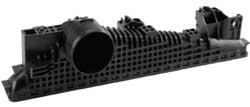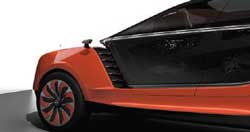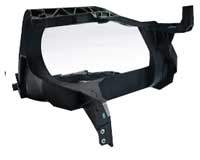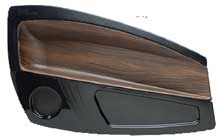K2016 Materials Review
Also, download this story from the electronic issue here
The K2016 show saw various materials advancements, especially for the automotive sector
- A new concept race car jointly developed by German
chemicals firm
BASF and Hyundai Motor, RN30, has
moved away from carbon fibre-reinforced polymer
(CFRP) to reduce weight, utilising BASF’s Elastolit rigid
integral foam and reaction injection molding (RIM)
systems developed for body panels. The latter are
said to permit challenging designs like the fender and
spoiler of the RN30 and allow for painting. The RN30
also features BASF’s Elastoflex E, a spray impregnation
PU for light and stiff sandwich structures consisting
of a long fibre-reinforced surface layer and a paper
honeycomb. Its Infinergy is the world’s first expanded
TPU, which combined with an elastic coating is used
in the roll bar padding of the RN30 for durability and
resilience. As for the braking system, BASF says it
developed a breakthrough technology, Hydraulan 406
ESI, which fulfills legislative requirements by extending
the durability of the brake elastomer. For electronic
assemblies of the RN30, BASF’s new Ultramid
Advanced N allows for miniaturisation and functional
integration. Other features undertaken by Hyundai
 include a bucket seat for racing, fitting the driver’s body
and an integrated roll cage, which increases the vehicle
body strength and protects the driver in precarious
situations. For the seat shell and pan, BASF offers
Ultracom, a thermoplastic composite system while its
near infrared-reflective films, protect windows against
solar heat and its waterborne ColorPro IC basecoat
“Performance Blue” is used on the exterior with a layer
of iGloss clearcoat.
include a bucket seat for racing, fitting the driver’s body
and an integrated roll cage, which increases the vehicle
body strength and protects the driver in precarious
situations. For the seat shell and pan, BASF offers
Ultracom, a thermoplastic composite system while its
near infrared-reflective films, protect windows against
solar heat and its waterborne ColorPro IC basecoat
“Performance Blue” is used on the exterior with a layer
of iGloss clearcoat.
- Solvay launched Technyl REDx, a new heat
performance PA66 integrating a “smart molecule”
self-reinforcement technology, said to outperform
conventional speciality polymers in demanding
thermal management systems. It includes a patented
self-strengthening technology present in the polymer
chain without affecting its structure. This technology
remains inactive during moulding of car parts, leaving
the material behaving like a high-flow PA66. During the vehicle’s use, the elevated temperatures activate
the smart technology, leading to rapid cross-linking
 that boosts the mechanical properties far beyond
their initial values. Technyl REDx can be processed at
temperatures below 100°C. Ageing tests over 3,000
hours at 220°C demonstrate high retention property
as well as tensile property gain of more than 50%,
without degradation of elongation at break. It is said to
help meet growing demand for downsized engines.
that boosts the mechanical properties far beyond
their initial values. Technyl REDx can be processed at
temperatures below 100°C. Ageing tests over 3,000
hours at 220°C demonstrate high retention property
as well as tensile property gain of more than 50%,
without degradation of elongation at break. It is said to
help meet growing demand for downsized engines. - Solvay also launched Technyl 4Earth, a postindustrial PA66 sourced from automotive airbags. Industrialised in Poland, the patented process is able to separate the nylon from the airbag's silicone. It had on display an automotive oil filter made of the material.
- What’s next for a company that has proven that
a solar-powered plane is possible? An electric
concept car! Germany-based Covestro’s featured
car, developed in collaboration with design students
from Sweden and Finland, showcases a wrap-around
glazing made of transparent PC, a new lighting concept
as well as seamless integration of the PC body with
the PC lighting. For the rear of the vehicle, together
with lighting and electronics supplier Hella, Covestro
developed a solution based on holographic films,
where various light functions can be integrated. Said
to be an industry first, Hella developed the holograms
before Covestro then incorporated these into a
 transparent holographic film, which retains the design
and is laminated onto a 3 mm glass plate. For series
applications, plastic will be used instead of glass. The
holographic film is illuminated from behind using
LED light sources and reflectors, resulting in a 3D
effect. Other new developments are the 70%-biomass
coating hardener while another hardener enables
plastic automotive add-on parts to be coated at low
temperatures.
transparent holographic film, which retains the design
and is laminated onto a 3 mm glass plate. For series
applications, plastic will be used instead of glass. The
holographic film is illuminated from behind using
LED light sources and reflectors, resulting in a 3D
effect. Other new developments are the 70%-biomass
coating hardener while another hardener enables
plastic automotive add-on parts to be coated at low
temperatures.
- Dutch materials
company DSM
launched its
third generation
ForTii Ace
polyphthalamide
 (PPA), as a
replacement
for die-cast
metal applications that require a
high mechanical performance at
temperatures as high as 150°C,
and costlier engineering resins
like PEEK. The resin has a glass transition temperature
of 160°C, said to be higher than other PPAs, and
80°C higher than PA66. It is targeted at powertrain,
transmission, chassis, and thermal management
applications.
(PPA), as a
replacement
for die-cast
metal applications that require a
high mechanical performance at
temperatures as high as 150°C,
and costlier engineering resins
like PEEK. The resin has a glass transition temperature
of 160°C, said to be higher than other PPAs, and
80°C higher than PA66. It is targeted at powertrain,
transmission, chassis, and thermal management
applications.
- Ineos Styrolution presented its StyLight composites,
said to be the first styrenic-based thermoplastic
composites available on the market, with stiffness
and impact strength properties exceeding PA6 and
PC-based composites. Based on a modified SAN, the
material is offered with both glass or carbon fibre
fabrics for semi-structural applications in automotive
interiors including seating modules, lower consoles,
instrument clusters and tailgate modules as well as
for electronics (eg. back covers of mobile devices),
medical industry (eg. prostheses, orthoses) and
sports equipment. The company says the material
 offers a thickness reduction of 50-70%, compared
to injection-moulded parts, resulting in a weight
reduction of up to 50%. It comes as semi-finished
goods or thermoplastic sheets, for processing via
thermoforming and over-moulding. Its surface
property allows a wide range of decorative solutions
from printing over foil lamination and conventional
painting.
offers a thickness reduction of 50-70%, compared
to injection-moulded parts, resulting in a weight
reduction of up to 50%. It comes as semi-finished
goods or thermoplastic sheets, for processing via
thermoforming and over-moulding. Its surface
property allows a wide range of decorative solutions
from printing over foil lamination and conventional
painting.
- Middle Eastern materials supplier Sabic highlighted the use of its Noryl GTX PPE/PA6 resin in an automotive body-in-white (BIW) reinforcement on Fiat Chrysler Automobiles’s 2015 Jeep Renegade. It reduced the weight by 45%, compared with an all-steel alternative. Through use of the resin in a thermoplastic honeycomb design with metal flanges, the automotive maker was also able to meet side impact protection requirements. An example of lighter bumper parts (Škoda Auto’s Fabia model) via thin-wall moulding of a new PP compound was also shown. The result allowed Tier 1 supplier Magna Exteriors to reduce the bumper’s thickness from 3 mm to 2.5 mm and reduce part weight by about 10%. Other new materials like its POM (unfilled polyoxymethylene or polyacetal), and Sabital glass fibre-reinforced polyacetal are targeted at automotive fuel pumps and door handles.
- US firm Celanese has entered the PEEK market with the launch of its Celapex solution that enables moulding of thin-wall, long-flow parts and facilitates ease of processing even at high filler loading. It is said to maintain many of the physical, mechanical, thermal, and electrical properties of PEEK. Furthermore, it launched a flexible Fortron PPS, which is heat-resistant, to meet the need for smaller engine compartments and complex industrial machinery that have high temperature requirements. The company said its new high-flow Celstran LFT (long fibre thermoplastics) cater to thinner (1-1.5 mm) and lighter parts. Initially offered as PP-based, other polymers can also be used. Targeted applications are front end panels.
- Elix Polymers’s new ABS/PC blend, Ultra HH 4115
HI, is to meet the trend to replace PC/ABS parts with
ABS/PC blends, especially for interior parts. The
material’s advantages include 5% lower density
with 1.07 g/cm³ versus PC/ABS 1.13 g/cm³, low
emission and odour. Its high flowability rate helps
to reduce cycle times. The Spanish firm says other
benefits include its high impact strength, good
processability and paintability. Tests according
 to ISO6603-2 (puncture impact behaviour) have
shown performance of the material at different
temperatures for crash-relevant parts such as interior
pillars. The appearance of the fracture was evaluated
as positive by several premium car manufacturers,
such as BMW that has approved it according to
GS93016 ABS+PC heat resistance. Another car maker
Audi is considering the material for lower instrument
panel parts, centre console parts and door panel
parts.
to ISO6603-2 (puncture impact behaviour) have
shown performance of the material at different
temperatures for crash-relevant parts such as interior
pillars. The appearance of the fracture was evaluated
as positive by several premium car manufacturers,
such as BMW that has approved it according to
GS93016 ABS+PC heat resistance. Another car maker
Audi is considering the material for lower instrument
panel parts, centre console parts and door panel
parts.
Home | Terms & Conditions | Privacy Policy | Contact | Webmail | Site Map
Copyright (c) 2016 www.plasticsandrubberasia.com. All rights reserved.













































